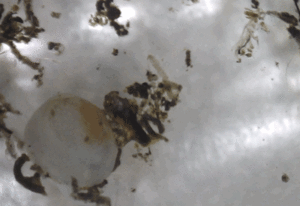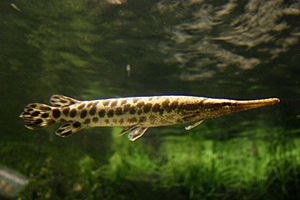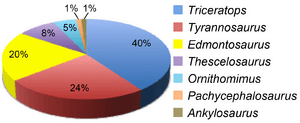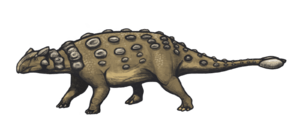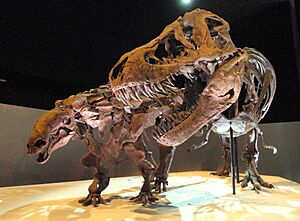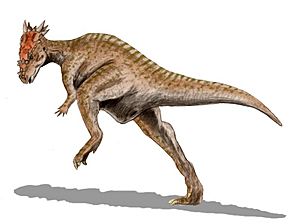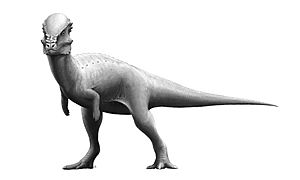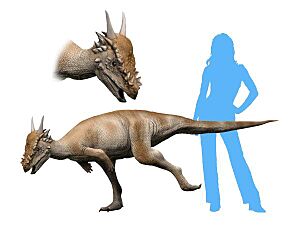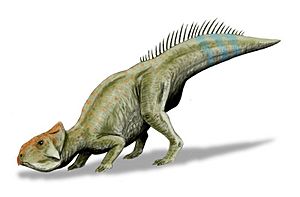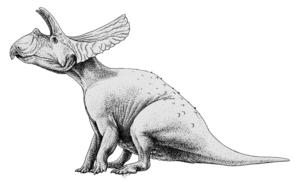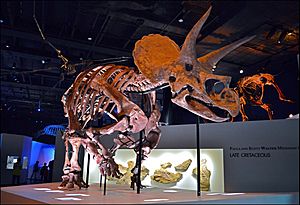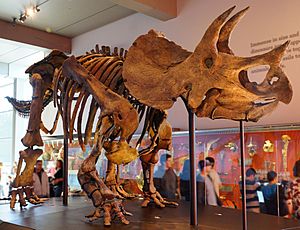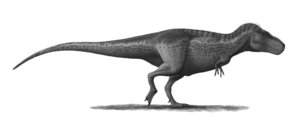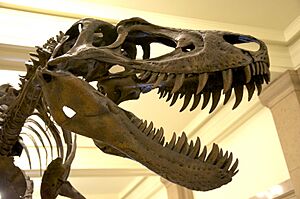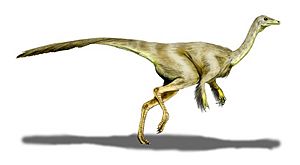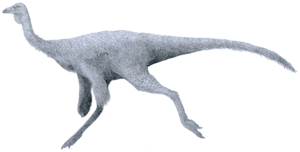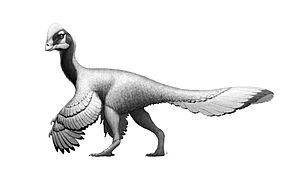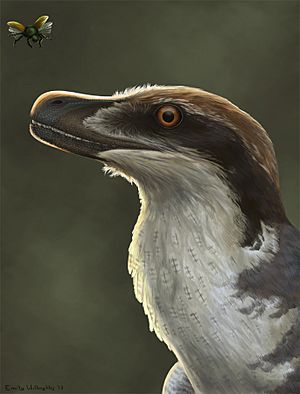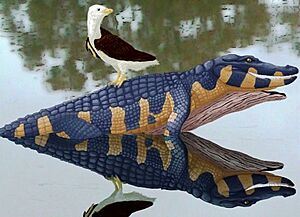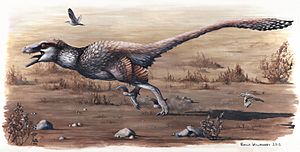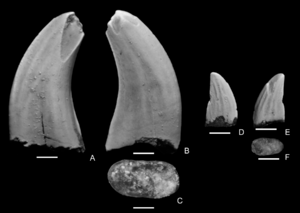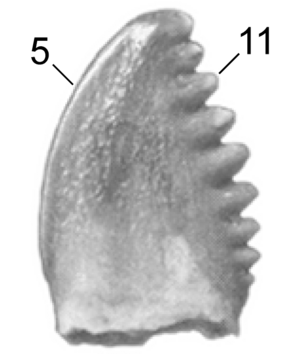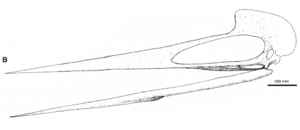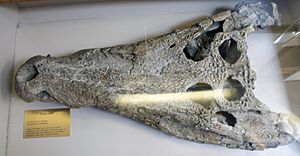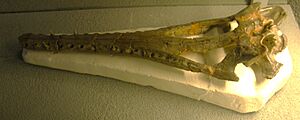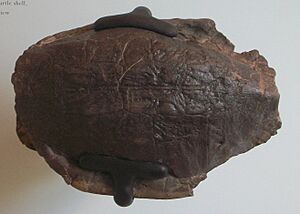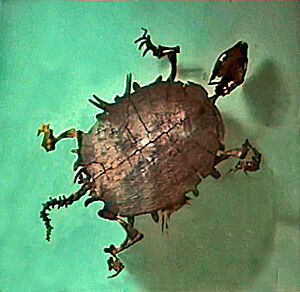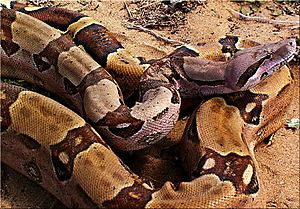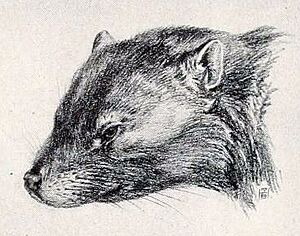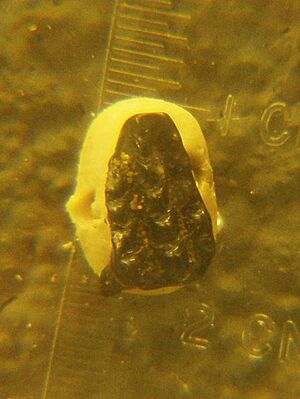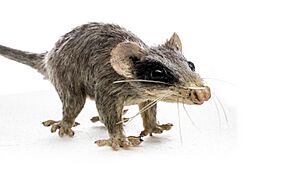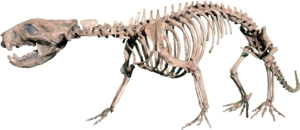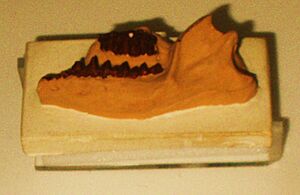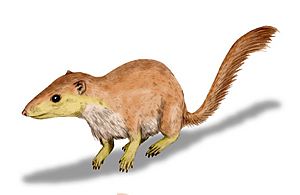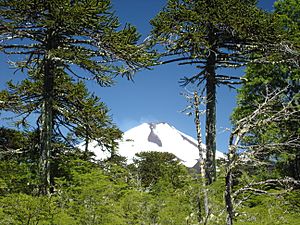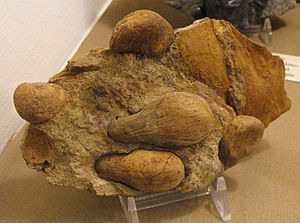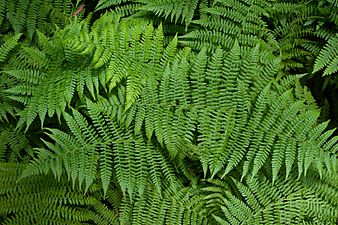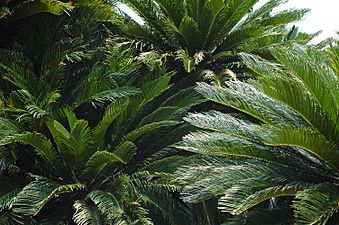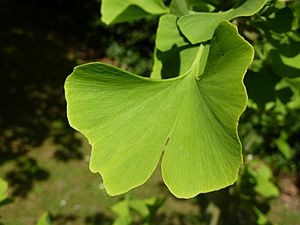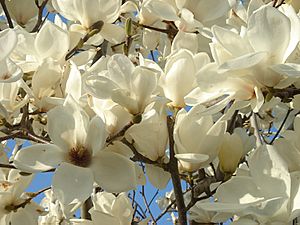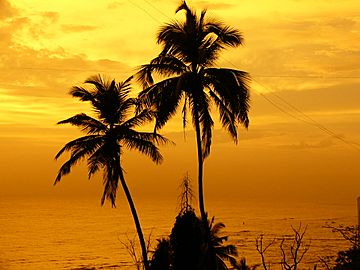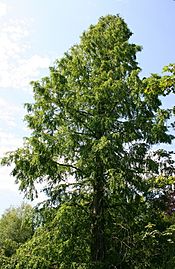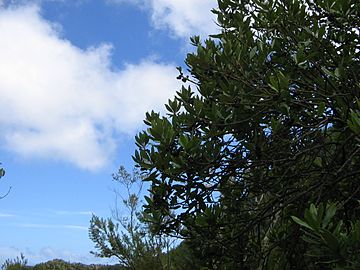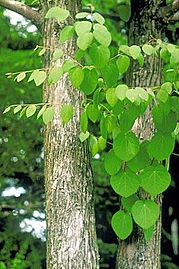Paleobiota of the Hell Creek Formation facts for kids
The Hell Creek Formation is a famous rock layer in North America, mostly found in Montana, North Dakota, and South Dakota. It's like a giant time capsule, holding amazing fossils from the very end of the Cretaceous Period and the start of the Paleogene Period. Scientists study these fossils to learn about the plants and animals that lived just before and after the big event that wiped out the dinosaurs. This article will explore some of the incredible creatures and plants discovered in the Hell Creek Formation.
Contents
Ancient Invertebrates
Invertebrates are animals without backbones, like insects and clams. In the Hell Creek Formation, scientists have found tiny fossils of insects like flies and damselflies preserved in amber. These insects, along with many other creatures, disappeared during the K-T Event, a huge extinction event that happened about 66 million years ago.
Many types of freshwater clams, also called pelecypods, lived here. Some common ones include Plesielliptio and Proparreysia. There were also freshwater snails like Campeloma. In areas where the ancient sea briefly covered the land, marine creatures like oysters (Crassostrea), cockles (Granocardium), and ammonites (like Sphenodiscus) have been found.
| Invertebrates | ||||||
|---|---|---|---|---|---|---|
| Genus | Species | Notes | Images | |||
| Plesielliptio | P. postbiplicatus | Freshwater clam | ||||
| P. gibbosoides | ||||||
| P. whitfieldi | ||||||
| Sphaerium | S. beckmani | Also called "fingernail clam" or "pea clam". | ||||
| Crassostrea | C. subtrigonalis | An ancient oyster found in marine areas. | ||||
| Sphenodiscus | S. lenticularis | An ammonite, a type of shelled creature related to squids. | ||||
Ancient Amphibians
Amphibians like frogs and salamanders were also part of the Hell Creek ecosystem. Many of their fossils are small and hard to identify, so scientists often find "indeterminate" remains, meaning they know it's a frog or salamander but can't tell the exact genus.
Some specific amphibian genera found include:
- Habrosaurus: A type of sirenid salamander.
- Scapherpeton: A very common scapherpetonid salamander in the Hell Creek Formation.
- Scotiophryne: A small frog.
| Amphibians reported from the Hell Creek Formation | |||||||
|---|---|---|---|---|---|---|---|
| Genus | Species | Notes | Images | ||||
| Anura (frog) | indeterminate | Frog fossils not assigned to a specific genus. | |||||
| Habrosaurus | H. dilatus | A type of sirenid amphibian. | |||||
| Scapherpeton | S. tectum | A very common salamander in this area. | |||||
| Scotiophryne | S. pustulosa | A small frog. | |||||
Ancient Fish
The rivers and lakes of Hell Creek were full of fish, both bony and cartilaginous.
Bony Fish
Bony fish (called Osteichthyes) were very common.
- Acipenser: An ancient sturgeon.
- Amia: A small fish closely related to the modern Bowfin.
- Lepisosteus: A very common lepidosteid fish, similar to modern gars.
- Melvius: A large fish also related to the Bowfin.
- Paleopsephurus: An ancient paddlefish.
| Bony fishes | ||||||
|---|---|---|---|---|---|---|
| Genus | Species | Notes | Images | |||
| Acipenser | A. eruciferus | An ancient sturgeon. | ||||
| Amia | A. fragosa | A small fish, common in Hell Creek. | ||||
| Lepisosteus | L. occidentalis | A very common fish, similar to modern gars. | ||||
| Melvius | M. thomasi | A large fish. | ||||
| Paleopsephurus | P. wilsoni | An ancient paddlefish. | ||||
Cartilaginous Fish
Cartilaginous fish (called Chondrichthyes), like sharks and rays, also lived in the Hell Creek area, especially in marine "tongues" or areas where the sea briefly extended inland.
- Galagadon: A carpet shark known from isolated teeth.
- Lonchidion: A prehistoric shark genus.
- Myledaphus: A type of ray related to guitarfishes, very common in the Hell Creek Formation.
- Restesia: A wobbegong-like shark.
| Chondrichthyes reported from the Hell Creek Formation | ||||||
|---|---|---|---|---|---|---|
| Genus | Species | Notes | Images | |||
| Galagadon | G. nordquistae | A carpet shark, known from teeth. | ||||
| Lonchidion | L. selachos | A genus of prehistoric sharks. | ||||
| Myledaphus | M. pustulosus | A ray related to guitarfishes, very common. | ||||
| Restesia | R. americana | A wobbegong-like shark. | ||||
Dinosaurs
The Hell Creek Formation is most famous for its dinosaurs! Scientists have studied the number of different dinosaur families found here. The most common dinosaur families were:
- Ceratopsidae (like Triceratops): 61%
- Hadrosauridae (like Edmontosaurus): 23%
- Ornithomimidae (like Ornithomimus): 5%
- Tyrannosauridae (like Tyrannosaurus rex): 4%
Studies show that Triceratops was the most common dinosaur. Surprisingly, Tyrannosaurus was found to be almost as common as, or even more common than, the duck-billed dinosaur Edmontosaurus in some areas. This was different from what scientists first thought!
Dinosaur footprints are very rare in the Hell Creek Formation. Only one possible Tyrannosaurus rex footprint has been found.
Ornithischians
Ornithischians are a group of dinosaurs that include armored dinosaurs, horned dinosaurs, and duck-billed dinosaurs.
Armored Dinosaurs (Ankylosaurs)
These dinosaurs had tough, bony armor.
- Ankylosaurus: A large, heavily armored dinosaur with a club tail.
- Denversaurus: Another type of armored dinosaur.
| Ankylosauria reported from the Hell Creek Formation | ||||||
|---|---|---|---|---|---|---|
| Genus | Species | Notes | Images | |||
| Ankylosaurus | A. magniventris | A large, armored dinosaur with a tail club. | ||||
| Denversaurus | D. schlessmani | A nodosaurid ankylosaur. | ||||
Dome-Headed Dinosaurs (Pachycephalosaurs)
These dinosaurs are known for their thick, dome-shaped skulls.
- Pachycephalosaurus: The most famous dome-headed dinosaur.
- Dracorex and Stygimoloch: These might actually be younger versions of Pachycephalosaurus, not separate species.
| Pachycephalosaurs reported from the Hell Creek Formation | ||||||
|---|---|---|---|---|---|---|
| Genus | Species | Notes | Images | |||
| Dracorex | D. hogwartsia | A pachycephalosaur, possibly a young Pachycephalosaurus. | ||||
| Pachycephalosaurus | P. wyomingensis | The most well-known dome-headed dinosaur. | ||||
| Stygimoloch | S. spinifer | A pachycephalosaur, also possibly a young Pachycephalosaurus. | ||||
Horned Dinosaurs (Ceratopsians)
Horned dinosaurs are very common in Hell Creek.
- Triceratops: By far the most common dinosaur found, with many teeth and bones. Two species, T. horridus and T. prorsus, are found.
- Torosaurus: A rarer horned dinosaur, possibly a very old Triceratops.
- Leptoceratops: A smaller, more primitive horned dinosaur.
| Ceratopsians reported from the Hell Creek Formation | |||||||
|---|---|---|---|---|---|---|---|
| Genus | Species | Notes | Images | ||||
| Leptoceratops | L. gracilis | A small, primitive horned dinosaur. | |||||
| Torosaurus | T. latus | A rare horned dinosaur, possibly a very old Triceratops. | |||||
| Triceratops | T. horridus | Very common horned dinosaur, found in the lower and middle parts of Hell Creek. | |||||
| T. prorsus | Very common horned dinosaur, found in the upper part of Hell Creek. | ||||||
Duck-Billed Dinosaurs (Ornithopods)
These plant-eating dinosaurs had beaks like ducks.
- Edmontosaurus: A very common duck-billed dinosaur.
- Thescelosaurus: A smaller ornithopod.
| Ornithopods and Thescelosaurs reported from the Hell Creek Formation | |||||||
|---|---|---|---|---|---|---|---|
| Genus | Species | Notes | Images | ||||
| Edmontosaurus | E. annectens | A very common duck-billed dinosaur. | |||||
| Thescelosaurus | T. garbanii | A small ornithopod. | |||||
| T. neglectus | A small ornithopod. | ||||||
Theropods
Theropods were mostly meat-eating dinosaurs, walking on two legs.
Tyrannosaurids
- Tyrannosaurus: The most famous meat-eating dinosaur. Many fossils, including young ones, have been found. Its teeth are quite common.
- Nanotyrannus?: This was once thought to be a separate, smaller tyrannosaur, but scientists now believe it was likely a young Tyrannosaurus rex.
| Tyrannosaurids reported from the Hell Creek Formation | |||||||
|---|---|---|---|---|---|---|---|
| Genus | Species | Notes | Images | ||||
| Tyrannosaurus | T. rex | The famous large meat-eating dinosaur. | |||||
| Nanotyrannus? | N.lancensis | Now thought to be a young Tyrannosaurus rex. | |||||
Ostrich-Mimic Dinosaurs (Ornithomimosaurs)
These dinosaurs looked a bit like ostriches, with long legs and necks.
- Struthiomimus and Ornithomimus: These were large, fast-running dinosaurs.
| Ornithomimids reported from the Hell Creek Formation | |||||||
|---|---|---|---|---|---|---|---|
| Genus | Species | Notes | Images | ||||
| Struthiomimus | S. sedens | A large ornithomimid, similar in size to a modern ostrich. | |||||
| Ornithomimus | O. velox | Another ostrich-mimic dinosaur. | |||||
Feathered Dinosaurs (Oviraptorosaurs)
Oviraptorosaurs were bird-like dinosaurs, some with crests.
- Anzu: One of the largest oviraptorosaurs known from North America.
| Oviraptorosaurs reported from the Hell Creek Formation | |||||||
|---|---|---|---|---|---|---|---|
| Genus | Species | Notes | Images | ||||
| Anzu | A. wyliei | One of the largest oviraptorosaurs. | |||||
Bird-Like Dinosaurs (Eumaniraptorans)
This group includes raptors and early birds.
- Acheroraptor: A velociraptorine raptor.
- Dakotaraptor: A large raptor, the second-largest dromaeosaurid known.
- Paronychodon and Pectinodon: These are known mostly from fossil teeth.
- Early birds like Avisaurus and Brodavis have also been found.
| Eumaniraptorans reported from the Hell Creek Formation | |||||||
|---|---|---|---|---|---|---|---|
| Genus | Species | Notes | Images | ||||
| Acheroraptor | A. temertyorum | A velociraptorine raptor. | |||||
| Avisaurus | A. archibaldi | An early bird. | |||||
| Dakotaraptor | D. steini | A large raptor. | |||||
| Paronychodon | P. caperatus | A troodontid theropod known from teeth. | |||||
| Pectinodon | P. bakkeri | A troodontid theropod known from teeth. | |||||
Pterosaurs
Pterosaurs were flying reptiles.
- Indeterminate azhdarchid remains: These large pterosaurs, possibly Quetzalcoatlus, have been found.
| Pterosaurs of the Hell Creek Formation | |||||||
|---|---|---|---|---|---|---|---|
| Taxa | Species | Notes | Images | ||||
| Azhdarchidae spp. | Indeterminate | Large flying reptiles, possibly Quetzalcoatlus. | |||||
Crocodylomorphs
These are ancient relatives of modern crocodiles and alligators.
- Borealosuchus: An extinct genus of crocodylians.
- Brachychampsa: An extinct alligatoroid.
- Thoracosaurus: An extinct gavialoid crocodilian.
| Crocodylomorphs reported from the Hell Creek Formation | |||||||
|---|---|---|---|---|---|---|---|
| Genus | Species | Notes | Images | ||||
| Borealosuchus | B. sternbergii | An extinct crocodile relative. | |||||
| Brachychampsa | B. montana | An extinct alligator relative. | |||||
| Thoracosaurus | T. neocesariensis | An extinct crocodile relative. | |||||
Turtles
Many types of turtles lived in the Hell Creek environment.
- Axestemys: A large softshell turtle.
- Gilmoremys: Another softshell turtle.
- Neurankylus: The largest baenid turtle in the Hell Creek Formation.
| Turtles reported from the Hell Creek Formation | |||||||
|---|---|---|---|---|---|---|---|
| Genus | Species | Notes | Images | ||||
| Axestemys | A. infernalis | A large softshell turtle. | |||||
| Gilmoremys | G. lancensis | A softshell turtle. | |||||
| Neurankylus | N. eximius | The largest baenid turtle in Hell Creek. | |||||
| Trionyx | Indeterminate | A softshell turtle. | |||||
Lizards and Snakes (Squamata)
The Hell Creek Formation also has fossils of lizards and snakes.
- Obamadon: A lizard named after former US President Barack Obama.
- Palaeosaniwa: A large lizard, related to modern monitor lizards. It was the biggest lizard in Hell Creek.
- Early boid snakes, related to modern boas, have also been found.
| Squamates reported from the Hell Creek Formation | |||||||
|---|---|---|---|---|---|---|---|
| Genus | Species | Notes | Images | ||||
| Obamadon | O. gracilis | A lizard named after Barack Obama. | |||||
| Palaeosaniwa | P. canadensis | The largest lizard in Hell Creek, related to monitor lizards. | |||||
| Boidae | Indeterminate | Earliest known boid snake. | |||||
Mammals
Even with giant dinosaurs around, small mammals were living in Hell Creek. They were mostly tiny creatures, often known from their teeth.
Multituberculates
These were an extinct group of mammals, some of the earliest to appear.
- Cimolomys and Meniscoessus: Common multituberculates.
- Mesodma: Another common type of multituberculate.
- Stygimys: An extinct multituberculate.
| Multituberculates reported from the Hell Creek Formation | ||||||
|---|---|---|---|---|---|---|
| Genus | Species | Notes | Images | |||
| Cimolomys | C. gracilis | A cimolomyid multituberculate. | ||||
| Meniscoessus | M. robustus | A common multituberculate. | ||||
| Mesodma | M. thompsoni | A common multituberculate. | ||||
Metatherians
This group includes early relatives of modern marsupials (like kangaroos and opossums).
- Alphadon: A small, primitive mammal related to marsupials.
- Didelphodon: A larger marsupial-like mammal from the Late Cretaceous.
| Metatherians reported from the Hell Creek Formation | ||||||
|---|---|---|---|---|---|---|
| Genus | Species | Notes | Images | |||
| Alphadon | A. marshi | A small, primitive mammal related to marsupials. | ||||
| Didelphodon | D. vorax | A marsupial-like mammal. | ||||
Eutherians
This group includes early relatives of modern placental mammals (like humans, dogs, and elephants).
- Gypsonictops: An early eutherian.
- Protungulatum: A very early placental mammal.
- Purgatorius: This genus is important because it might be one of the earliest ancestors of primates (the group that includes monkeys, apes, and humans).
| Eutherians reported from the Hell Creek Formation | ||||||
|---|---|---|---|---|---|---|
| Genus | Species | Notes | Images | |||
| Gypsonictops | G. illuminatus | An early eutherian mammal. | ||||
| Protungulatum | P. coombsi | A very early placental mammal. | ||||
| Purgatorius | P. ceratops | Possibly one of the earliest primate relatives. | ||||
Ancient Flora
The Hell Creek Formation was a wet, forested floodplain with many types of plants. Even though leafy trees and grasses existed, the forests were mostly made up of conifers.
The climate was warmer than today, as shown by the presence of palm trees. Other common trees included laurels, sycamores, beech trees, and magnolias. Ferns and moss grew on the forest floor.
After the K-T extinction event, there was a big increase in fern spores, a phenomenon called "the fern spike." This suggests that ferns were among the first plants to recover after the disaster. Most of the flowering plant genera found in Hell Creek are now extinct.
Some of the plants found in Hell Creek include:
- Various ferns and cycads.
- Conifers like Metasequoia (dawn redwood) and Glyptostrobus.
- Ginkgo trees (though uncommon).
- Many types of angiosperms (flowering plants), which made up about 90% of the plant fossils. These included relatives of modern breadfruit, katsura trees, magnolias, and plane trees.
It's important to know that some plant names from Hell Creek might not be exactly the same as modern plants with similar names. Scientists are still studying these ancient plants to understand them better.
-
Ferns from Hell Creek
-
Cycads are found in Hell Creek
-
Ginkgo (uncommon) are found in Hell Creek
-
Various angiosperms from Hell Creek
-
Monkey-puzzle leaves are found in Hell Creek
-
Fossil palm trees indicate a hotter ancient climate.
-
Redwood seed cones are known from Hell Creek
-
Magnolia is commonly found in Hell Creek
- Plants of the Hell Creek Formation
- Araucaria (Monkey-puzzle tree relatives)
- Elatocladus (Taxodiaceae)
- Glyptostrobus
- Metasequoia (Dawn Redwood)
- Taxodium (Bald Cypress relatives)
- Ginkgo adiantoides (the only ginkgo found here)
- Annona? (custard apple relatives)
- Artocarpus (breadfruit relatives)
- Bisonia (a common broad leaf plant)
- Cercidiphyllum (katsura tree relatives)
- Cinnamomum (cinnamon relatives)
- Dombeyopsis
- Dryophyllum (beech/chestnut-like trees)
- Ficus (fig relatives)
- Grewiopsis
- Juglans (walnut relatives)
- Laurel family (Lauraceae)
- Liriodendron (tulip tree relatives)
- Magnolia
- Myrica
- Palms (Arecaceae)
- Palaeoaster (a poppy relative)
- Pistia (water lettuce)
- Platanus family (plane tree/sycamore relatives)
- Populus (poplar relatives)
- Rhamnus (buckthorn relatives)
- Vitis (grape relatives)
- Zingiberopsis (ginger relatives)


